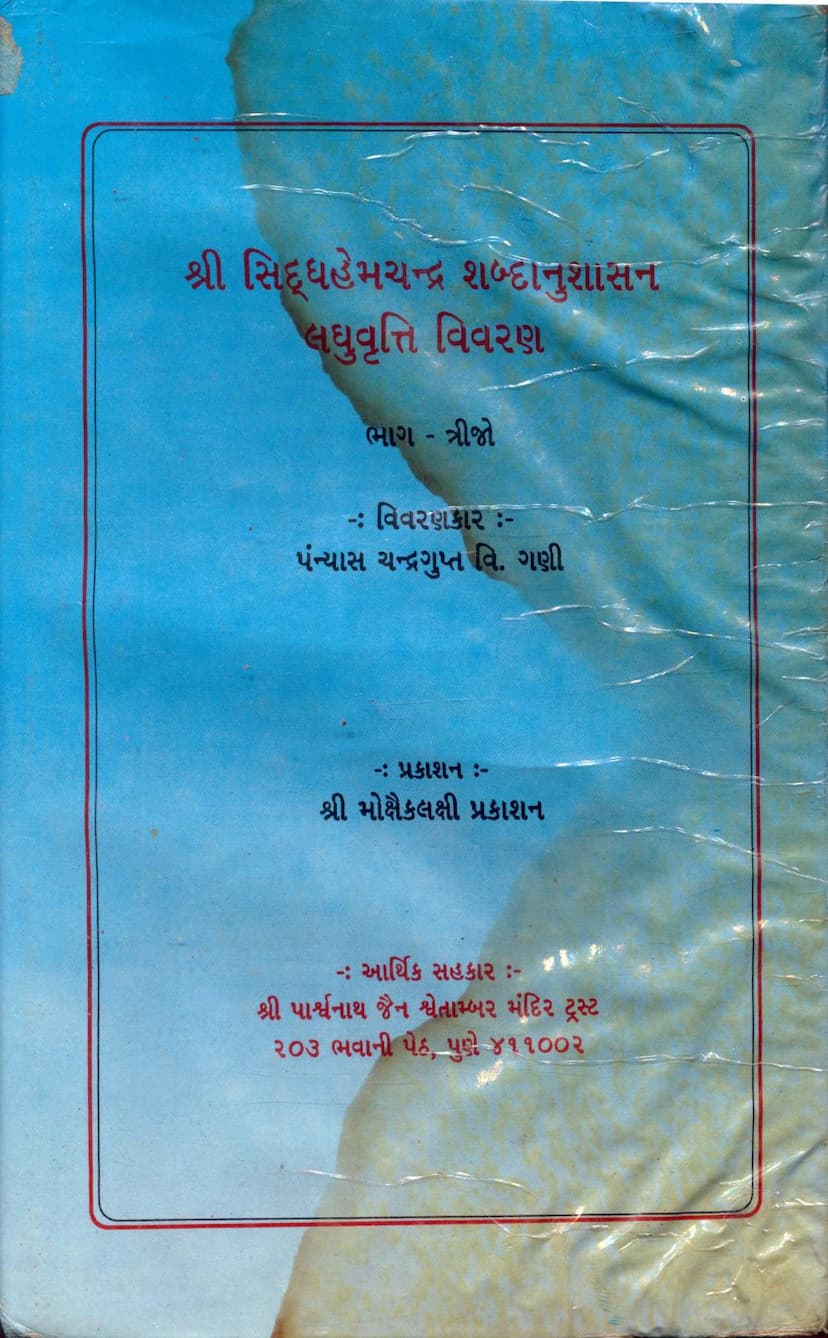Siddhhemchandra Shabdanushasan Laghuvrutti Vivran Part 03
Added to library: September 2, 2025

Summary
This is a summary of "Siddhhemchandra Shabdanushasan Laghuvrutti Vivran Part 03" by Chandraguptavijay, published by Mokshaiklakshi Prakashan. The book is a commentary (Vivran) on the "Siddhhemchandra Shabdanushasan" by Hemchandracharya, a foundational text for Jain grammar.
Overall Context:
The "Siddhhemchandra Shabdanushasan" is a comprehensive Sanskrit grammar text that follows the tradition of Panini's Ashtadhyayi but is tailored to the specific linguistic needs and philosophical context of Jainism. The "Laghuvrutti Vivran" is a detailed commentary providing explanations, examples, and elaborations on the sutras (rules) presented in the original grammar. This particular volume, Part 03, appears to delve into advanced grammatical concepts, likely focusing on compound words (Samasa), verb conjugations (Akhyata), and other complex aspects of Sanskrit morphology and syntax, especially as they relate to Jain terminology and concepts.
Content of Part 03 (Based on the provided pages):
The provided pages showcase the beginning of the third chapter (Adhyaya) and cover several sutras that deal with the formation of compound words (Samasa) and the application of grammatical rules in various contexts. Here's a breakdown of the key themes and concepts covered in these pages:
- Introduction to the Third Chapter: The text begins by stating the commencement of the third chapter, indicating a shift to new grammatical rules.
- Focus on Compound Words (Samasa): A significant portion of the text is dedicated to explaining the formation of various types of Samasa, including:
- Avyayibhav Samasa: Formation of compounds where the first member is an indeclinable (Avyaya). The commentary details various rules and conditions for these formations, often specifying the meaning that drives the compound. Examples illustrate the application of rules related to prefixes (upasargas) and other indeclinable words.
- Tatpurusha Samasa: This is a major area of focus, with numerous sutras dedicated to different types of Tatpurusha compounds. The commentary explains rules based on the relationship between the words (e.g., possession, relation, instrument, location) and the specific case endings involved.
- Bahuvrihi Samasa: Rules for forming compounds where the meaning of the compound is external to the members of the compound itself are discussed. The commentary highlights how these compounds often describe a possessor or a characteristic.
- Karmadharaya Samasa: The commentary likely explains Karmadharaya compounds, which are a subtype of Tatpurusha where the words have a descriptive relationship.
- Dvandva Samasa: While not explicitly detailed in the early pages, the latter part of the provided text touches upon Dvanda Samasa, which involves the coordination of two or more independent words.
- Role of Indeclinables (Avyayas): The text frequently discusses how indeclinables, when they precede a verb or noun, affect the meaning and grammatical structure, often forming Avyayibhav Samasa.
- Meaning-Driven Grammar: The commentary emphasizes how the intended meaning (artha) is crucial in determining the correct application of grammatical rules and the formation of compounds.
- Specific Grammatical Operations: The text elaborates on specific grammatical operations like:
- Samjna (Designation): Assigning specific grammatical terms or classifications to words.
- Pratyaya (Suffixes): The use and modification of suffixes.
- Agama (Addition): The addition of letters or sounds.
- Guna (Vowel Change): Rules governing vowel modifications.
- Lopa (Omission): Rules for omitting certain elements.
- Adesha (Substitution): Rules for replacing sounds or parts of words.
- Illustrative Examples: Each grammatical rule is typically followed by numerous examples, often derived from classical Sanskrit literature or specifically crafted to demonstrate the rule's application.
- Corrections and Errata: The latter pages indicate a significant number of corrections (Shuddhi Nirdesh) for Part 03, suggesting potential issues in the initial typesetting or printing. This highlights the detailed and meticulous nature of the commentary.
Key Jainological Significance:
While the text is fundamentally a grammar book, its Jain context is important:
- Jain Terminology: The rules and examples would be applied to Sanskrit words and phrases used in Jain literature, philosophical texts, and narratives. This means the grammar is not just about Sanskrit but also about understanding and accurately interpreting Jain religious and philosophical discourse.
- Preservation of Language: The commentary aids in the accurate understanding and preservation of the Sanskrit used in the Jain tradition, ensuring the correct interpretation of their scriptures.
- Scholarly Tradition: The detailed nature of the commentary reflects a long and rich tradition of Jain scholarship in linguistics and philosophy.
In essence, Part 03 of this commentary provides an in-depth grammatical treatise, primarily focusing on the intricacies of Sanskrit compound formation and related modifications, all within the framework of Jain linguistic tradition.